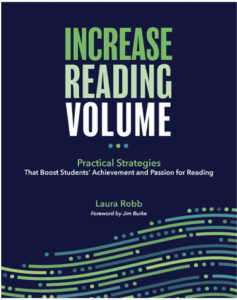How to Teach Reading in the Middle Grades
Dr. Laura Robb is widely recognized as one of the nation’s leading experts on methods to effectively teach reading and literacy. Her practical approaches and expertise with middle grades students shine through in this master-class article on using formative data to target and address “small confusions.”
By Laura Robb

Their formative assessments revealed the need to practice looking for context clues before and after the sentence that contains the new word. Every two to three weeks, Mr. Grant (a pseudonym) reviews his various sources – students’ written work, self-evaluations, and his observational notes – to target specific learning needs.
He uses these specifics to support students before small confusions transform into obstacles. While Mr. Grant works with one to three groups and/or individuals, the rest of the class completes independent reading of self-selected books or writing about reading in notebooks.
With just 60 minutes to teach reading and writing, Mr. Grant divides each nine-week semester into separate reading and writing workshops. Since his goal is to respond to the needs of students, he isn’t rigid about this time division. Based on what students require, he often adds days to either subject.
The formative assessments he uses to advance students’ progress work well in daily 45 to 50 minute classes and a block schedule. By reserving time for students who require re-teaching and/or targeted practice, Mr. Grant can improve their reading skill, and then they can successfully participate in mini-lessons and daily practice.
Take a Deep Dive Into Formative Assessments
Formative assessments are your opportunities to provide immediate feedback to students. Assessments contain the information you need to support instructional planning such as deciding whether to generate a small group with common needs or to provide interventions for individual students. Based on students’ daily performance, formative assessments identify their strengths, small confusions, and larger challenges.
By acting on this information in a timely fashion, you can plan targeted lessons that support small groups and positively affect members’ learning, engagement and motivation to read at key points in their development. Also keep in mind that formative assessment is ongoing, ungraded, and emerges from the daily lessons and work that students do in the classroom.
Seven Formative Reading Assessments
These seven are a menu for you to choose from. Assess students’ work, observe them, and invite them to self-evaluate their comprehension, application of reading strategies, discussions, and writing about reading in their notebooks. Under each assessment, you’ll find questions in italics that can guide your intervention and teaching decisions.
►1. Observe students’ responses, questions, and levels of participation during mini-lessons and interactive read alouds. Date and jot your observations for each student in a notebook when you have time.
Do students’ responses show understanding or confusions? Do their questions ask for clarification or are they off topic? Is their participation frequent or not at all? What strengths do you notice? What needs?
►2. Watch students during independent reading when the expectation is that they quickly find a comfortable spot and concentrate on reading for fifteen or more minutes. Besides reading a book for part of the time, consider having one to three brief conferences with individuals that might include topics such as choosing a book that interests them and they can read, setting goals about the number of pages they can read and focus on, or noting how their reading stamina has improved.

►3. Observe individuals and partners during instructional reading when students engage in short discussions with their partners and refer to the text to collect evidence to support their ideas.
Do pairs contribute equally? Do they stay on topic? Do they include text evidence as support? Do they respect each other’s ideas? Can they apply reading strategies? Do they connect ideas within a text? Can they use context clues to figure out the meaning of unfamiliar words? Is the book a good fit for both?
►4. Listen to student-led literary discussions and whether members listen to peers, respond to what a peer says, ask clarifying questions, politely disagree, and value diverse interpretations. Focus on one or two different groups each time they meet to have a discussion. However, to develop a sense of what’s happening in all groups, invite students to self-evaluate after three to four discussions and then compare their views of their participation to your own observations.
What do students’ self-evaluations reveal? Do all students participate? Do they respond to what a peer says? Do they offer text evidence to support their ideas? Do they listen without interrupting? Do they value diverse ideas?
►5. Checking oral reading fluency provides insights into students’ accuracy, prosody or expressive reading, phrasing, and reading rate. Disfluent reading affects comprehension because the focus is on decoding words, and the process can become labored and slow, often preventing students from thinking about meanings and ideas while reading.
Do students need word work that focuses on word families? Would repeated readings through practice and performance of poems support them? Are the texts too challenging? Would students benefit from models of expressive reading?
►6. Enlarge students’ background knowledge that includes vocabulary related to a topic and genre structure because prior knowledge and vocabulary affect recall and comprehension.
Should you introduce words related to a topic before students read? Can they use context clues to figure out the meaning of new words? Can they connect their background knowledge to details in the text?
►7. Read two to three notebook entries to discover students’ level of understanding about what they’ve been practicing. Invite students to turn down a page they want you to read and select a page at random. If you need to read a third entry to better understand a student’s thinking, take the time to do it.
Do students respond to the question/prompt? Do responses show they can apply strategies such as inferring to think with depth about characters and theme? Can they organize ideas into a logical sequence? Can they identify and also cite text evidence to support theme? Characters’ personality traits? Conflicts and problems? Are entries becoming more detailed?
Note students who ask questions that reveal they’re finding some of the work a challenge. Talk to them. Learn more. Pinpoint the issue and decide whether to support them in a small, flexible group or a one-on-one intervention.
Reserve Class Time for Interventions
I recommend gathering formative assessment data over two to three weeks, which should provide enough time for students to apply and practice what they’re learning. In your notebook, date a page and head it with the assessment you’re observing. Then create a list of students who might need more support along with any questions your notes may raise. If you have doubts about whether a student needs extra support, hold a brief conference with them to learn more prior to making a decision.
While you work with small groups or individuals, it’s important for the rest of the class to complete substantive and authentic work that that they can successfully complete independently, so they won’t interrupt your work with students. Two choices that can advance students’ progress in reading follow.
► Independent Reading of self-selected books builds students’ stamina as they concentrate for fifteen minutes or more on books they can read with 98 to 100 percent accuracy. Independent reading should be easy and enjoyable, enabling students to practice the strategies learned during mini-lessons and instructional reading. It also increases students’ recall and comprehension, expands their understanding of the structures of different genres, and boosts their reading volume.
► Notebook Writing about their readings can improve analytical and critical thinking as students write about characters and why they change, identify themes, make connections within their books and to other texts, and apply strategies that develop high-order thinking. Teachers can post on a white board their mini-lesson writing or an entry from their own notebooks. Both are resources that can maintain students’ independence while teachers work with a group.
Support Students With Conferring
One-on-one conferences and/or conferring with pairs are excellent places to start using formative assessments to improve students’ reading because they can be scheduled during independent reading and/or when students complete notebook writing.
You can hold short five-minute conferences to re-teach a lesson, invite students to practice applying a strategy in front of you, complete repeated readings of short poems for fluency, or work on adding text evidence to discussions and notebook writing. If students require more than one to two conferences, continue meeting with them until they meet the purpose of the intervention.
Support Students With Flexible Grouping
Flexible grouping provides opportunities for students to work with different peers, as this type of grouping honors learner diversity and responds to the specific needs students reveal. This means that flexible groups are temporary and can be homogeneous or heterogeneous, and students practice together until they understand the learning objective.
Most likely, a group will need more than one meeting, and it’s also possible you could be working with three or four different groups. I suggest you try to set aside no more than twenty to thirty minutes for group work, so you can continue reading aloud, presenting mini-lessons, and engaging students in instructional reading as well as finding time for student-led discussions, notebook writing, and conferring.
It’s possible you’ll have four groups, and I suggest you work with two every other time your class meets. The good news is that flexible grouping won’t occur every week of the school year – there will be weeks when your formative assessments indicate that all students can move forward without intervention. There remains a question, though, that you’ll need to address: How can I meet the needs of every student in my class?
If you have an inclusion class and a resource teacher who pushes in each time class meets, then together, you can target all students’ needs using formative assessments and flexible grouping or conferring. If some students have a separate class at a different time with a reading resource teacher, then collaborate with that teacher to find:
►appropriate reading and writing tasks they can complete independently; and
►suggestions for small group work on a specific strategy or skill.
When you support students who need additional instruction in conferences or small groups, you can positively affect their reading growth and gains and desire to read.
Impact Students’ Reading Progress
By using formative assessments to target and support students’ specific reading needs, you’re differentiating instruction and positively impacting their progress. Timely interventions that address small confusions can improve students’ comprehension, their ability to recall details to interpret texts’ meanings, as well as show their depth of understanding a text through discussions and writing.
By finding the time to support all students, you’re also telegraphing how much you value their learning, and that with your scaffolding and their sustained effort, challenges can become the progress needed to develop a love of reading.
Also see Laura’s MiddleWeb article
Make It Happen: Reading Growth for All Students

Laura’s most recent book is Increase Reading Volume: Practical Strategies That Boost Students’ Achievement and Passion for Reading (NCTE, 2022), reviewed here.






























